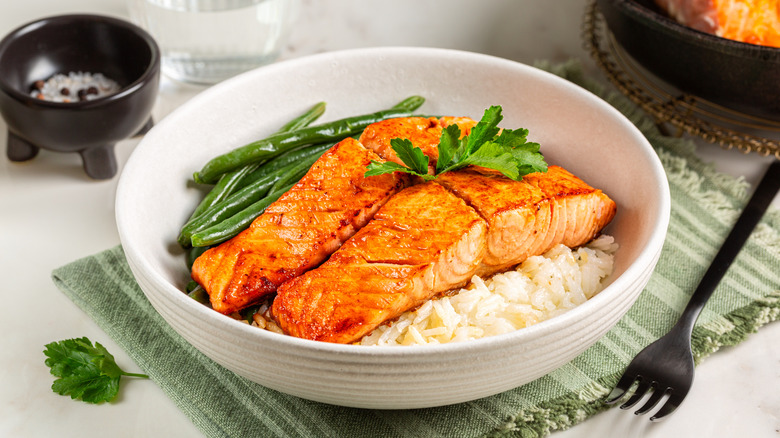Why Wild And Farm-Raised Salmon Aren't Cooked The Same Way
You probably noticed some major differences between wild and farm-raised salmon the first time you looked at them side-by-side. As opposed to the pale pink of your standard, affordable grocery store salmon, the coho or sockeye next to it in the cooler will be a vibrant reddish-orange, with far meatier-looking flesh. And once you cook it, you'll actually taste the big difference between wild and farm-raised salmon: You can't actually make them the same way. Try a piece of fresh wild salmon in a recipe you normally make with farmed, and it's likely to be dry and mealy, even as the flavor itself has surprising depth. And the reason for that is the difference in how wild and farm-raised salmon spend their lives.
Wild salmon is a lot leaner than farm-raised, which is what accounts for both its firmer flesh and its propensity to dry out faster. While farmed salmon sit in densely populated pools where they get fed, wild salmon have intense lives where they journey thousands of miles, and all that extra exercise burns off a lot of fat. In fact, you can easily spot the difference in your salmon, as those white streaks of fat between the flesh of wild salmon are often razor-thin. And fat has a big impact on how any protein is cooked. It provides moisture as the salmon is heated and the fat melts, and it impacts the taste by adding extra richness.
Wild salmon's hard-working life makes the meat leaner but more flavorful
While that lack of fat is often considered an issue when cooking, it isn't all bad for wild salmon. Just like with hard-working cuts of beef like brisket, salmon that gets more work may be leaner, but that exertion also develops a more meaty flavor. The more varied diet of wild salmon also adds to the meat's taste and makes it more complex. So while farmed salmon will taste richer, the flesh of its wild equivalent is more intense.
Thankfully, the adjustment to cooking wild salmon isn't too difficult. If you have a thermometer, cooking wild salmon to 120 degrees Fahrenheit instead of the 125 recommended for farmed salmon is enough to keep it tender. Like with tougher meat, cooking it slower in the oven at lower temperatures in baked salmon recipes also lowers the risk of it drying out. You can even quickly brine wild salmon in salted water for 15 to 30 minutes to give it more moisture before you cook.
Because it's extra fat, farmed salmon will take better to high-heat searing, but you'll also need to boost its milder flavor with powerful ingredients like in miso salmon. Wild salmon's robust natural flavor is more versatile. It can stand up to strong flavors but also has enough taste to be given a lighter touch. But account for the difference between the two and either can make a satisfying and tasty meal any night of the week.

